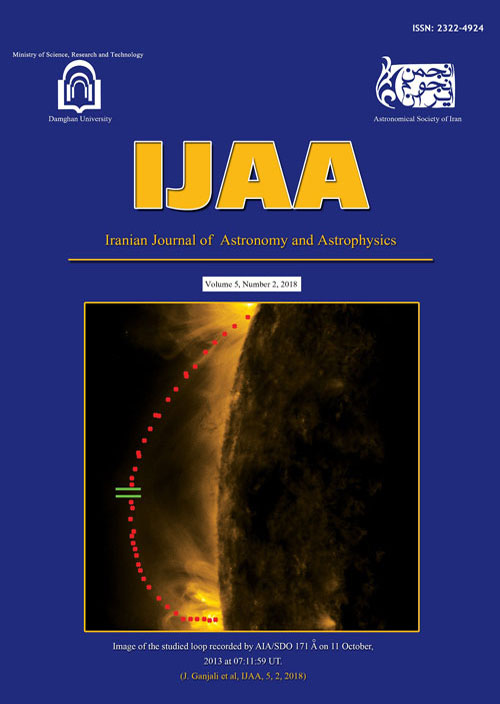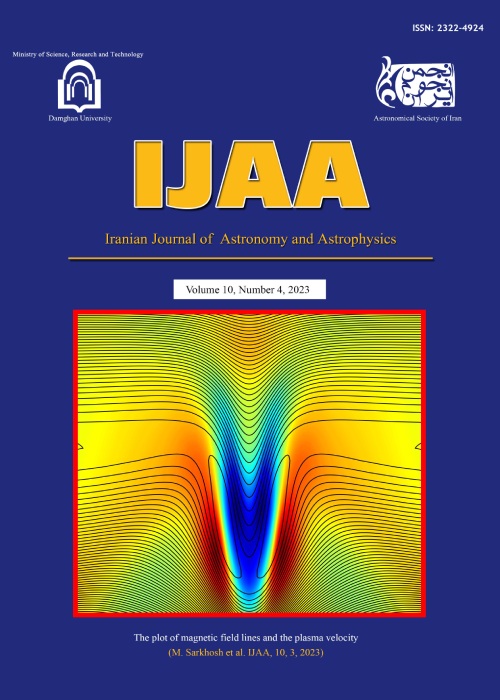فهرست مطالب

Iranian Journal of Astronomy and Astrophysic
Volume:6 Issue: 2, Autumn 2019
- تاریخ انتشار: 1398/09/10
- تعداد عناوین: 6
-
-
صفحات 79-93
توزیع زمان فرود ذرات بهمنهای گسترده هوایی برای بهمنهایی شبیه سازی شده با انرژی 100 تا 10000 ترا-الکترون ولتی که توسط ذرات اولیه پروتون تولید شده اند، برای سطح مشاهده آرایه البرز در تهران مورد مطالعه قرار گرفت. ما نتایج تحلیل توزیع زمان فرود ذرات بهمنهای شبیه سازی شده در چندین ناحیه در جبهه ی بهمن را ارایه کردیم. این نواحی طوری انتخاب شده اند که تغییرات ضخامت بهمن با فاصله از مرکز آن، و زاویه سمتی را در بهمنهای مایل نشان دهند. با استفاده از انحراف معیار توزیع زمانی به عنوان شاخصی برای ضخامت جبهه ی بهمن، و با تعریف نواحی مشاهده مناسب در سطح زمین، یک عدم تقارن در ضخامت جبهه ی بهمنهای مایل مشاهده شد. به نظر میزسد که ضخامت جبهه ی بهمنهای مایل در نواحی که زودتر به زمین می رسند، بیشتر از نواحی است که دیرتر به زمین می رسند. برداشت اشتباهی که از ضخامت بهمنهای مایل درپژوهش دیگری به وجود آمده بود تصحیح شد. پیامدهای این موضوع برای افزایش دقت تخمین جهت محور بهمن مورد بحث قرار گرفته است.
کلیدواژگان: بهمنهای گسترده هوایی، پرتوهای کیهانی، توزیع زمانی -
صفحات 107-116
در این پژوهش، رصدهای نورسنجی توسط سی سی دی در رصدخانه RIAAM و آنالیزهای منحنی نوری ستاره KIC 12418816 ارایه میشود. برای مقایسه، داده های نورسنجی دوره طولانی (LC) کپلر نیز مطالعه شد. برای آنالیز منحنی نوری رصد شده در فیلتر R و داده های نورسنجی کپلر، از نرم افزار PHOEBE که از آخرین نسخه کد Wilson-Devinney بهره می برد، استفاده شد. در آغاز، جست و جوی نسبت جرم (q=m2/m1) سیستم دوتایی با پیدا کردن کمینه مقدار χ2 (که تمامی منابع نویز را شامل می گردد) صورت گرفت. با استفاده از مدل سازی داده های بدست آمده از رصدهای ما، مقدار نسبت جرم در حدود 76/0 برآورد شد. این مقدار با مقدار بدست آمده از مدل سازی داده های LC کپلر که مقدار نسبت جرم را 75/0 ارایه کرد، قابل مقایسه بود. رصدهای ما نشان داد که دمای موثر (Teff) برای همدم اولیه و ثانویه به ترتیب برابر با 4421 و 4412 کلوین است که مشابه با نتایج بدست آمده از داده های کپلر می باشد (برابر با 4463 و 4419 کلوین به ترتیب برای همدم اولیه و ثانویه). مدل سازی این سیستم همچنین نشان داد که می توان یک لک بر روی همدم اولیه تعریف کرد.
کلیدواژگان: تکنیک داده کاهی، نورسنجی، دوتایی گرفتی، داده کپلر -
صفحات 117-125
ایستگاه های رادیویی قادر به ثبت شدت میدان الکتریکی ایجاد شده توسط بهمن های گسترده پرتو کیهانی هستند. با استفاده از آرایه ای از آنتن های رادیویی که در نواحی مشخص فرکانسی کار میکنند می توان الگوی این تابش رادیویی را در محل مشاهده بدست آورد. در کار حاضر با استفاده از شبیه سازی کامپیوتری مشخصه های مختلف الگوی تابش رادیویی حاصل از پرتوهای کیهانی با تابش عمودی و مایل،در محل اولین آرایه رادیویی پرتو کیهانی در خاورمیانه SURAبدست آمده است و تاثیر زاویه سرسویی و فاصله بین آنتن ها بر روی الگوی تابشی مورد بحث قرار گرفته است.
کلیدواژگان: پرتوهای کیهانی، آشکارسازی رادیویی، بهمن های گسترده هوایی، SURA
-
Pages 71-78By orbit-limited motion (OLM) theory and the kinetic model, currents carried by electronsand ions on the dust grain are obtained and the effects of temperature and drift velocity of ions on thedust grain electrical potential are considered. The calculations were performed for finding the role of densities of dust grains and ions on the dust grain electrical potential which is the main factor in determining the tendency of the grain for acquiring more charge. It is shown that the dust grain electrical potential and thus the dust grain charge are affected by density of ions (electrons) and dust grain. Moreover, it is found that as the ratio of temperature electron-to-ion is raised, the plasma with heavier ions experiences the larger electric potential of the dust grain. Furthermore, it is indicated that the dust grain electrical potential for the potassium plasma is significantly higher than the oxygen plasma. Finally, it is shown that by decreasing the dust grain electrical potential and the electron temperature, the drift velocity of ions is increased.Keywords: electron temperature, drifting ions, charging dust grains, orbit motion limited theory, dusty plasma
-
Pages 79-93
The arrival time distribution of simulated extensive air shower particles, for $10^{14}-10^{16}$ eV showers initiated by protons, for the observation level of the ALBORZ-I array in Tehran, has been investigated. We report the results of our analysis on the arrival time spread of simulated shower particles in several regions in the shower front, which are suitably chosen to demonstrate the variation of shower thickness with the core distance, and azimuth angle, for slanted showers of different zenith angles. Using the standard deviation of the time distribution as an indicator of the shower thickness, and defining appropriate observation zones on the ground, we found an asymmetry in the shower thickness of slanted showers. It seems that the early parts in the shower front are thicker than the late parts. A misinterpretation of the thickness of slanted shower fronts in an other research has been corrected. Implications for improvement of accuracy in the shower axis direction estimation has been discussed.
Keywords: Extensive Air Showers, Cosmic Rays, Time Distribution -
Pages 95-106
In this paper, the problem of small amplitude dust-ion acoustic (DIA) solitary waves is discussed using the reductive perturbation theory in magnetized plasmas consisting of superthermal electrons, inertial ions, and negatively charged stationary dust grains. Presented investigation shows that the effects of external magnetic field and superthermal electrons significantly modify the basic properties of DIA solitary waves, so that an enhancement in the electron superthermality causes to decrease the soliton width. Moreover, when the magnetic field increases, the width of soliton decreases, and in a consequence, it makes the solitary structures be more spiky. In the following, it is found out that the soliton compression and rarefaction are sensitive to the degree of electron superthermality and dust concentration. As well as, the value of obliqueness index has bright effect on adjusting the amplitude of the positive and negative solitary waves. It is expected that the results of this study will give more insight into the DIA dynamics in dusty astrophysical and laboratory plasmas.
Keywords: Dust-ion-acoustic solitary waves, magnetic field, Superthermal electrons -
Pages 107-116
Here, the photometric CCD observations in RIAAM observatory and light curve analyses of KIC 12418816 are presented. For comparison, the Kepler long cadence (LC) photometric data was studied. The analyses of the recorded light curve in R-band filter and Kepler LC photometric data were performed by PHOEBE software by using the last version of Wilson-Devinney code. Initially, the search of mass ratio (q=m2/m1) of the binary system was done with finding the minimum chi-square value (cost function χ^2), which takes all sources of noise in to account. By photometric modeling which was obtained from our observations, the mass ratio was calculated as about 0.76. The results were comparable with modeling extracted from Kepler LC data which was obtained about 0.75. Our observations showed that the effective temperature (Teff) for primary and secondary stars were about 4421 and 4412 Kelvin, respectively. The similar results were obtained from Kepler LC data which were about 4463 and 4419 for primary and secondary stars, respectively. Our modeling demonstrated that we can introduce a spotted model with one spot on the primary component.
Keywords: Data reduction techniques, Photometry, Eclipsing Binary, Kepler data -
Pages 117-125
Radio stations can record di erent values of the electric eld strength from an extensive air shower induced by a cosmic ray. It is possible to derive the ground footprint of a cosmic ray using the calculated electric eld strength recorded by a proper set of radio antennas in a speci c frequency range. In this study and based on computer simulations we investigate the properties of the ground foot-prints of vertical and inclined cosmic rays propagating in a location of a new cosmic ray radio experiment in the Middle East. Semnan University Radio Array is a new radio detection site that aims to detect ultra-high energy cosmic rays. We investigate the e ect of the zenith angle of a cosmic ray on the illuminated area as a result of radio emission from an extensive air shower development. The maximum possible spacing between radio antennas in order to be able to detect coincident events for both vertical and inclined cosmic rays at the location of this new experiment is also discussed.
Keywords: Cosmic Rays, Radio detection, SURA, Extensive Air Showers -
Pages 127-133
Cherenkov radiation is one of the problems in light- matter interaction that can be opened new ideas in quantum electrodynamic. A quantum mechanic approach is presented for Cherenkov radiation of a moving atom in uniaxial and biaxial anisotropic medium. A moving particle in a medium emits Cherenkov radiation when its speed be larger than the phase velocity of light in the medium. The electromagnetic field is quantized in the anisotropic media, using maxwell and related constitute equations, phenomenologically. The Cherenkov radiation for an moving charged particle in the anisotropic medium with arbitrary real permittivity tensor is obtained. The dielectric structure can be changed the Cherenkov radiation. For uniaxial media, we give a close form of the Cherenkov radiation for arbitrary dipole alignment. In this manner, the Cherenkove radiation of the biaxial media is calculated.. It is shown the Cherenkov radiation in an isotropic medium can be obtained from the form of an anisotropic medium.
Keywords: Biaxial media, Cherenkov Radiation, Uniaxil medai


